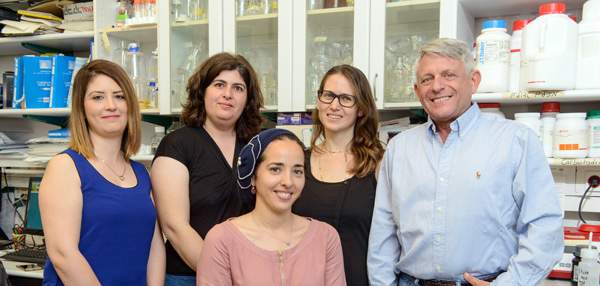Are you a journalist? Please sign up here for our press releases
Subscribe to our monthly newsletter:
Although humans and cows have very different diets, new research shows that we share with them at least one tool for digesting our food. Specifically, we share a common type of bacterium living in our respective digestive systems that bears this tool -- a protein complex called a cellulosome on the bacterial cell surface that breaks down the tough cellulose in plants. Research by Prof. Ed Bayer of the Weizmann Institute’s Biomolecular Sciences Department, and his colleagues, suggests that the cellulose-eating habits of these bacteria may have implications for human health, including possible ties to obesity, metabolic syndrome and diabetes.
Bayer and his colleague at Tel Aviv University, Prof. Raphael Lamed, had originally discovered the cellulosome in 1983, on a bacterium that naturally breaks down the cellulose in such organic matter as dead wood. Their research over the years has shown that the cellulosome is recognizable by its unique, Lego-like assembly of proteins, including a string of backbone proteins and a series of attachable enzyme units. These chop up the long, indigestible sugar chains in cellulose into simple sugars that other bacteria can then consume.

“The new discovery,” says Bayer, “actually started with the cow.” Bayer had met Prof. Harry Flint of the University of Aberdeen, UK, at a conference where Flint described a component of the cow-rumen bacterium he was studying. Bayer recognized in the description the components of a cellulosome. But Flint’s picture of the cow’s cellulosome was incomplete, and thus began a long collaboration with Bayer’s lab to study the structure and function of this machinery in an animal’s digestive system.
The bacteria in a cow’s rumen are the main agents of digestion, breaking down into shorter bits the cellulose and other long polysaccharide molecules in hay and grass. The group’s research showed that the cellulosomes on these bacteria are built on the same basic plan as those in the wood-eating bacteria, with attachable enzymes that are adapted to breaking down the cellulose in the grasses.
We humans, of course, digest most of our food without the aid of bacteria, but a body of research in recent years shows that we, too, rely on the activities of the populations of bacteria in our intestinal tracts – our microbiomes. Our microbiomes have now been found to affect everything from our weight to our metabolic and immune system functions. With the flood of new research describing the genetics of microbiome populations, Bayer and his colleagues managed to find cellulosomes in bacteria that live in the human small intestine. It was a French team that published the genome of a human intestinal bacterium that appeared to be similar to the cow bacterium and in which, says Bayer, “we smelled cellulosome-like elements.”
The new discovery actually started with the cow
Bayer, senior intern Dr. Sarah Moraïs, postdoctoral fellow Bareket Dassa and research student Yonit Ben David, together with Flint, Lamed and Ilya Borovok; as well as Nicole M. Koropatkin and Eric C. Martens of University of Michigan Medical School, and Annick Bernalier-Donadille, head of the French group at INRA, France, went to work on the genetic sequence of this bacterium. At first, their results were inconclusive. There were some cellulosome components in the bacterial genome, but there appeared to be too few to make a complete cellulose-eating machine. On closer inspection, however, the team found that several segments of the genome had been overlooked in their search. When Moraïs carefully sequenced the missing segments, the verdict was in: These particular human gut bacteria carry cellulosomes.
In parallel research, Bayer and his colleagues found yet another new cellulosome-bearing bacterium in the human microbiome. This one, rather than digesting cellulose, is tailored to breaking down indigestible starch molecules.
These cellulosomes as well as the bacteria that carry them are very closely related to their cow counterparts. Since we don’t normally live off grass or hay, why do we have these bacteria? Bayer thinks they may have a protective function – preventing damage to the soft tissue of our digestive tract from the abrasive cellulose fibers we ingest in our fruit and vegetables. But the bacteria are also part of a class of intestinal bacteria that are thought to affect our metabolism, including our tendency to obesity, metabolic syndrome and diabetes. So the findings point to further avenues of research, and they suggest that the cellulosome may indeed be crucial to our health and well-being.
Prof. Ed Bayer's research is supported by the Dana and Yossie Hollander Center for Structural Proteomics; the Leona M. and Harry B. Helmsley Charitable Trust; and the Jewish Community Endowment Fund. Prof. Bayer is the incumbent of the Maynard I. and Elaine Wishner Professorial Chair of Bio-Organic Chemistry.